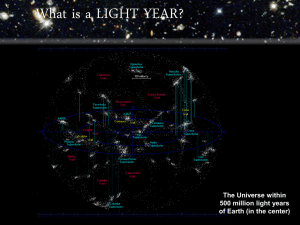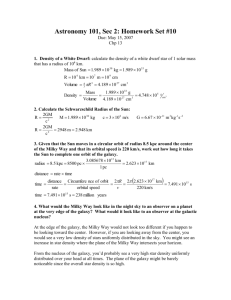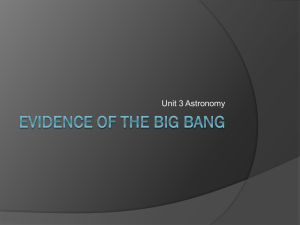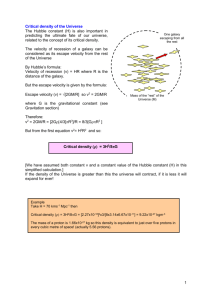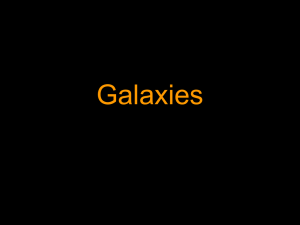Hubble Constant - Indiana University
advertisement
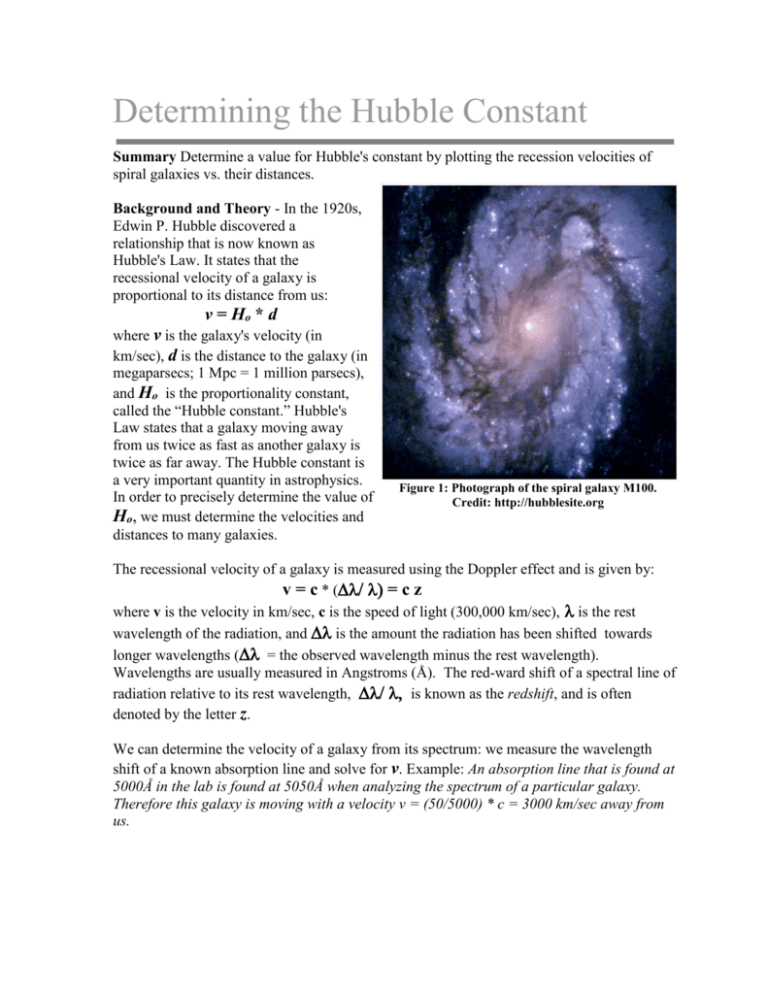
Determining the Hubble Constant Summary Determine a value for Hubble's constant by plotting the recession velocities of spiral galaxies vs. their distances. Background and Theory - In the 1920s, Edwin P. Hubble discovered a relationship that is now known as Hubble's Law. It states that the recessional velocity of a galaxy is proportional to its distance from us: v = Ho * d where v is the galaxy's velocity (in km/sec), d is the distance to the galaxy (in megaparsecs; 1 Mpc = 1 million parsecs), and Ho is the proportionality constant, called the “Hubble constant.” Hubble's Law states that a galaxy moving away from us twice as fast as another galaxy is twice as far away. The Hubble constant is a very important quantity in astrophysics. In order to precisely determine the value of Ho, we must determine the velocities and distances to many galaxies. Figure 1: Photograph of the spiral galaxy M100. Credit: http://hubblesite.org The recessional velocity of a galaxy is measured using the Doppler effect and is given by: v = c * (= c z where v is the velocity in km/sec, c is the speed of light (300,000 km/sec), is the rest wavelength of the radiation, and is the amount the radiation has been shifted towards longer wavelengths ( = the observed wavelength minus the rest wavelength). Wavelengths are usually measured in Angstroms (Å). The red-ward shift of a spectral line of radiation relative to its rest wavelength, is known as the redshift, and is often denoted by the letter z. We can determine the velocity of a galaxy from its spectrum: we measure the wavelength shift of a known absorption line and solve for v. Example: An absorption line that is found at 5000Å in the lab is found at 5050Å when analyzing the spectrum of a particular galaxy. Therefore this galaxy is moving with a velocity v = (50/5000) * c = 3000 km/sec away from us. A trickier task is to determine a galaxy's distance, since we must rely on more indirect methods. One may assume, for instance, that all galaxies of the same type are the same physical size, no matter where they are. This is known as "the standard ruler" assumption. To determine the distance to a galaxy one would only need to measure its apparent (angular) size, and use the small angle equation: a = s / d, where a is the measured angular size (in radians!), s is the galaxy's true size (diameter), and d is the distance to the galaxy. Measuring the Doppler Shifts: Open the Excel spreadsheet hubbleconstant.xls and open the worksheet labeled Data. This Excel spreadsheet is “pre-loaded” with equations to help you calculate the redshifts of the galaxies. You will have to measure the positions of three different spectral lines for eight of the nine galaxies that are listed in the spreadsheet. If you type in the measured wavelength of the line (in Angstroms), the spreadsheet will then calculate the redshift for you, using the equation given above. Once you have measured all three spectral lines, the spreadsheet will average the redshifts for you, and will compute the recessional velocity for this galaxy. (Note: Before you type in your measurements, all the redshift values should equal -1, and all the velocities should equal -300,000.) To find the spectra of the galaxies, go to the following web site: http://www.astro.washington.edu/labs/hubblelaw/galaxies.html There you will find a list of galaxies (not all of which appear in your spreadsheet. Be sure to choose only those galaxies which are listed in the spreadsheet.) Click on Spectrum for a given galaxy. This will bring up a web page that shows several different types of spectra for each galaxy. The optical spectrum of the galaxy is shown at the top of the spectrum page. Shown are many different spectral features, including absorption lines and emission lines, superimposed on continuum emission from the galaxy, over the entire visible-light bandpass. Below the full optical spectrum are enlarged portions of the same spectrum, in the vicinity of some common spectral features. (Note: You will not need to use all the spectra that are given on this page for this exercise. You will only use the Ca H/K and H sub-spectra.) The small dark bars near the lower left corner of the sub-spectrum indicate the rest wavelengths of particular lines. Measure the wavelength by clicking at the middle of the spectral line in the galaxy's spectrum. Important note: Ca H and Ca K are “absorption lines” – this means that they look like big dips in the spectrum. The spacing between these two dips is approximately the same as the spacing between the two small dark bars that show their rest wavelengths. Try to select the deepest point in each dip for your measured wavelength. In contrast, H is a strong “emission line” – the tallest sharp peak in the spectrum. For more information on absorption and emission lines, see http://en.wikipedia.org/wiki/Spectral_line. Try to select the point at the peak for the measured wavelength of this line. A new web page will come up that tells you the wavelength that you have measured. Type (or copy and paste) the resulting wavelength into the spreadsheet in the darker-colored cell, underneath the correct spectral line, and on the row for that galaxy. For example, the value for the Ca K line for NGC 2276 is typed into cell B6. Representative values for NGC 2276 have also been pre-loaded for you – you can redo these values or check to make sure you agree with these values, and then continue on with the other eight galaxies on the spreadsheet. Use this procedure to find the red-shifted wavelengths for Ca K, Ca H and H lines for each of the remaining eight galaxies in the spreadsheet. Tip: Use Ctrl C and Ctrl V to copy and paste the values from the webpage into the spreadsheet. The spreadsheet will then calculate the redshift for each spectral line, will average the three measurements together to find the average redshift (column E) and will multiply by the speed of light to find the recessional velocity (column F.) Return to the spectrum of a given galaxy by clicking on the link, e.g. Back to the spectrum of NGC2276 . Move on to the next galaxy by clicking on the link Galaxy selection table . Measuring the Apparent Sizes of the Galaxies: Return to the galaxy selection table http://www.astro.washington.edu/labs/hubblelaw/galaxies.html and select Image for each galaxy in the spreadsheet. Find the angular size of the galaxy using its image. The images used in this lab are negatives, so that bright objects -- such as stars and galaxies --appear dark. There may be more than one galaxy in the image; the galaxy of interest is always the one closest to the center. To measure the size, click on opposite ends of the galaxy, at either end of the longest diameter. Be sure to measure all the way to the faint outer edges. Otherwise, you will dramatically underestimate the size of the galaxy, and introduce a systematic error. The angular size of the galaxy (in milliradians; 1 mrad = 0.057 degrees = 206 arcseconds) will be displayed; record this number in the Excel spreadsheet in the dark box in column G for each galaxy. (A measurement for the angular size of NGC2276 has already been inserted for you. The rest of this column is pre-loaded with “1” to avoid errors in the spreadsheet for the calculation of the distances in column H. All values in column H will start out equal to 22 but will change when you replace the “1” in column G with the measured angular size for each galaxy.) The spreadsheet assumes that all of these galaxies are about the same size, 22 kpc (1 kpc = 1000 pc) across and calculates the distance to each galaxy using the small angle formula, adapted for the units we are using here: d (Mpc) = s (kpc) / a (mrad) Compare your recession velocities to the distances you calculated for the different galaxies. Do they make sense? Keep in mind that the further away a galaxy is from us, the faster it will be moving. Determining the Hubble Constant: Click on the sheet labeled Hubble Constant. The plot should have used the values for Distance and Velocity that were calculated on the Data sheet. It should also have fitted a trendline and determined the equation of this line. The slope of this line is the Hubble Constant in the funny units of km/sec/Mpc. (The Hubble constant tells you how by many km/sec the velocities of the galaxies increase per Megaparsec of distance traveled.) Your data probably do not make a perfect line, and the R-value will tell you how well the line fits your data. If the R-value is below 0.90, you may wish to recheck some of your “outlying” data points. (The most probable error is underestimating the angular size of the galaxy on the image.) When you update the values on the Data sheet, the plot will automatically update itself to use the new data and will recalculate the trendline and R-values. Once you are satisfied with your data and linear fit, use the Hubble constant (slope of the line) value to do the following calculations: If the universe has been expanding at a constant speed since its beginning, the universe's age would simply be 1/Ho. First, convert Ho to inverse-seconds (1/sec). Since 1 Mpc = 3.09 x 1019 km , this entails dividing your calculated value for the Hubble Constant by 3.09 x 1019 km. Now calculate the "expansion age" of the universe: t = 1/Ho. This gives an approximate age of the universe in seconds. To convert this number into years, divide it by 31,536,000 (the number of seconds in a year). Expansion age of the Universe = ___________________________________ This is a very simple model for the expansion of the universe. A better model would account for the deceleration caused by gravity. Models like this predict the age of the universe to be: t = 2/(3Ho). Re-calculate the age using this relation. t = _______________________________________ How does this value compare to the age of the Sun, which is about 4.5 billion years old? This exercise is based on one developed at the University of Washington (© 1999 University of Washington) and has been revised for use in the "Exploring the Dark Universe" Workshop for teachers at Indiana University.


